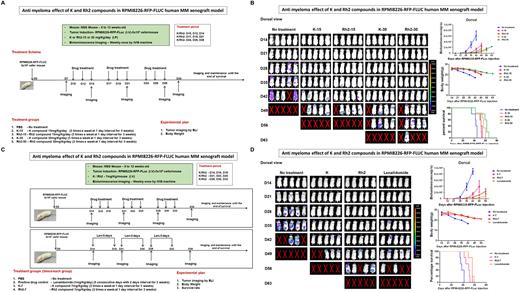Abstract
Introduction: Several ginsenosides have demonstrated anti-cancer activity due to their ability to inhibit DNA synthesis and angiopoiesis, inducing cancer death. Rh2, a PPD-type 20(S)-ginsenoside, has been extensively studied as a major ingredient with antineoplastic properties. Moreover, the characteristics of compound K (CK), a PPD ginsenoside metabolite, resulting from the metabolic activity of enterobacteria, have been investigated. The effect of ginsenoside has been actively studied in leukemia but not in multiple myeloma (MM). Thus, the aim of study was to identify ginsenosides that have toxic effects against MM cells and to elucidate the underlying molecular mechanism.
Methods: First, we screened the toxic effects of ginsenosides Rb1, Rb3, Rg1, Rg3, Rh1, Rh2, and CK at a concentration of 50 μM in several MM cell lines (ARH77, U266, and RPMI8226) after 24 hours of exposure. Furthermore, ARH77 cells were incubated with Rh2 and CK at 0, 20 μM, 50 μM, 60 μM, and 70 μM for 24 hours, and the DNA content at each stage of the cell cycle was detected. The potential cytotoxic effect of Rh2 and CK was investigated in normal hematopoietic stem cells (HSCs) isolated from healthy donors using primary peripheral blood stem cells (PBSCs). For this experiment, HSCs were isolated using a PBSC collection procedure after the recruitment of healthy donors. Briefly, granulocyte colony-stimulating factor was administered continuously until the white blood cell count exceeded the threshold of 1 × 109 cells/L. The subjects underwent leukapheresis once or twice using a blood cell separator. To quantify the production of PBSCs from each leukapheresis, flow cytometry was carried out to quantify CD34+ cells. To establish a human MM xenograft model, RPMI8226-RFP-FLuc cells (5 × 106 per mouse) were intravenously injected into 9-12-week-old male and female NOD/SCID IL-2Rγnull (NSG) mice. To assess the anti-MM effect of CK and Rh2 in the MM xenograft model, NSG mice were divided into the following treatment groups: Experiment set 1: no treatment (PBS control), CK (15 mg/kg/day), Rh2 (15 mg/kg/day), K (30 mg/kg/day), and Rh2 (30 mg/kg/day). Mice were treated with either CK or Rh2 (15 or 30 mg/kg/day) by intraperitoneal injection for 3 days in a week at a 1-day interval. Experiment set 2: no treatment (PBS control), CK (7 mg/kg/day), Rh2 (7 mg/kg/day), and Lenalidomide (1 mg/kg/day). Mice were treated with either CK or Rh2 (7 mg/kg/day) by intravenous injection for 3 days in a week at a 1-day interval. Lenalidomide (1 mg/kg/day) treatment was given by oral administration from day 14 for 5 consecutive days in a week, and it was repeated for 3 weeks at a 2-day interval in each week. Tumor growth was monitored weekly by bioluminescence imaging in the dorsal view; 10 min before imaging, mice were intraperitoneally injected with D-Luciferin (150 mg/kg/mouse).
Results: The ginsenosides Rh2 and CK inhibited the cell growth, exerted cytotoxicity, and induced G1 phase cell cycle arrest in human MM cells. However, these treatments demonstrated no cytotoxic effect on the self-renewal and the differentiation capacity of normal primary PBSCs. This observation implied that the cytotoxic activity of Rh2 and CK might selectively target MM cells and that these ginsenosides are safe in other cell types. Finally, we studied the anti-MM effect of CK and Rh2 in a clinically relevant human MM xenograft model. PBS was given in the no treatment control group and all untreated tumor-bearing mice showed rapid tumor growth and severe plasmacytoma, which led to death within 7 weeks. Notably, mice treated with CK and Rh2 showed significant inhibition of tumor growth and a longer survival.
Conclusions: Ginsenosides CK and Rh2 inhibited the growth of MM cells in an in vitro and in vivo model without any significant cytotoxic effect on the self-renewal and differentiation capacity of PBSCs. Thus, these ginsenosides could be used in MM treatment and can be combined with drugs without exerting any severe toxic effects.
Keywords: Ginsenosides; Rh2; Compound K; Multiple myeloma
Disclosures
No relevant conflicts of interest to declare.
Author notes
Asterisk with author names denotes non-ASH members.


This feature is available to Subscribers Only
Sign In or Create an Account Close Modal